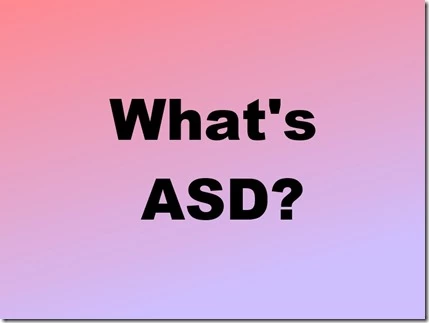 Next up in our survey of things to know from DSM-5: Autism spectrum disorder (ASD). As ever, the net provides the essentials. The change, from Wikipedia:
Next up in our survey of things to know from DSM-5: Autism spectrum disorder (ASD). As ever, the net provides the essentials. The change, from Wikipedia:
The new diagnosis encompasses previous diagnoses of autistic disorder, Asperger's disorder, childhood disintegrative disorder, and PDD-NOS. Rather than categorizing these diagnoses, the DSM-5 [adopts] a dimensional approach to diagnosing disorders that fall underneath the autism spectrum umbrella. It is thought that individuals with ASDs are best represented as a single diagnostic category because they demonstrate similar types of symptoms and are better differentiated by clinical specifiers (i.e., dimensions of severity) and associated features (i.e., known genetic disorders, epilepsy and intellectual disability).
The complete diagnostic criteria are posted at Autism Speaks. Here are the bullets:
A. Persistent deficits in social communication and social interaction across multiple contexts, as manifested by the following, currently or by history
B. Restricted, repetitive patterns of behavior, interests, or activities, as manifested by at least two of the following, currently or by history
C. Symptoms must be present in the early developmental period (but may not become fully manifest until social demands exceed limited capacities, or may be masked by learned strategies in later life).
D. Symptoms cause clinically significant impairment in social, occupational, or other important areas of current functioning.
E. These disturbances are not better explained by intellectual disability (intellectual developmental disorder) or global developmental delay. Intellectual disability and autism spectrum disorder frequently co-occur; to make comorbid diagnoses of autism spectrum disorder and intellectual disability, social communication should be below that expected for general developmental level.
Don't be surprised to find ASD questions on the social work licensing exam. Imagine a straightforward symptom vignette and "What is the BEST diagnosis?" It's not going to be any of the DSM-IV-TR diagnoses that've disappeared, right? If you're seeing A-E above, the diagnosis--the right answer--is ASD. For still more detail, try these sites:
***
To practice with realistic exam questions about ASD, the DSM-5, and much more, sign up!

 Next up in our survey of things to know from DSM-5: Autism spectrum disorder (ASD). As ever, the net provides the essentials. The change, from
Next up in our survey of things to know from DSM-5: Autism spectrum disorder (ASD). As ever, the net provides the essentials. The change, from